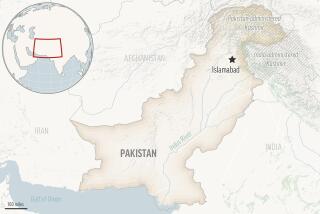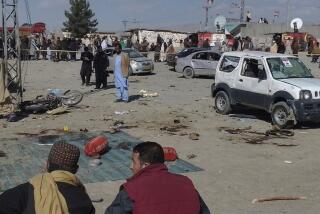Suicide bombers kill 41 in Pakistan
- Share via
Reporting from Islamabad, Pakistan — A pair of suicide bombers attacked a large gathering of anti-Taliban elders inside a government compound in northwestern Pakistan on Monday, killing at least 41 people in one of the worst terrorist strikes in the volatile tribal belt this year.
The attack occurred in the town of Ghalanai at the administrative headquarters of Mohmand, a region along the Afghan border that continues to see periodic clashes between Taliban militants and Pakistani troops. A meeting was underway at the compound between leaders of a local anti-Taliban militia and a top Mohmand official, authorities said.
Witnesses said more than 300 people were in the building when the two attackers appeared. One of the bombers wore a police uniform and was able to walk into the offices where the crowd had gathered. A second bomber was stopped at a perimeter security gate. The men detonated their explosives seconds apart.
Officials in Mohmand said the compound had metal detectors at its entrance but that they were not functioning because of a power outage.
One witness said he was waiting in the building to meet an official when “suddenly there was a huge blast. I fell on the ground. When I stood up, there was another blast. As I again fell to the ground, I saw people running in panic.”
Pakistani television showed sections of the compound reduced to rubble and a long line of wounded people being rushed on stretchers into a hospital in Peshawar, the largest city in the northwest. More than 70 people were injured in the attack.
Anti-Taliban tribal meetings and pro-government tribal militias have been frequent targets of insurgents in recent years. On Jan. 1, a man driving a pickup filled with explosives set off a blast near the town of Lakki Marwat, where members of a militia were playing volleyball. At least 96 people were killed.
In July, two suicide bomb blasts tore through a busy market in the village of Yakka Ghund in Mohmand, killing at least 102 people in an attack that authorities said appeared to be aimed at members of a militia who had been meeting in the area.
Mohmand is one of several tribal regions along the Afghan border where Taliban and Al Qaeda militants maintain hide-outs. The Pakistani military has launched offensives in several parts of the northwest, including the Swat Valley, South Waziristan, Bajaur, Orakzai and Khyber, in hopes of ending the wave of Taliban-engineered suicide bombings and other terrorist acts that have ravaged the country in recent years.
Despite the offensives, top Taliban leaders remain active. Many militants were able to flee the military operations well in advance and find sanctuary elsewhere in the semiautonomous tribal belt.
The border between Afghanistan and Mohmand, as well as other regions in the tribal belt, are poorly guarded and extremely porous, making it easy for militants to escape and return. Mian Iftikhar Hussain, information minister of Khyber-Pakhtunkhwa province, said regional militancy could be defeated only if Pakistan better coordinated its counter-terrorism efforts with U.S. and Afghan forces battling insurgents on the Afghan side of the border.
“There is a need for an organized and comprehensive strategy in the fight against terrorists in Afghanistan, the tribal areas and Pakistan,” Hussain said. “Otherwise we will keep suffering. There are predictions that this wave of terrorism may continue for the next 14 years. God knows what will happen if terror keeps hitting us for 14 more years.”
Special correspondents Nasir Khan in Islamabad and Zulfiqar Ali in Peshawar contributed to this report.
More to Read
Sign up for Essential California
The most important California stories and recommendations in your inbox every morning.
You may occasionally receive promotional content from the Los Angeles Times.










